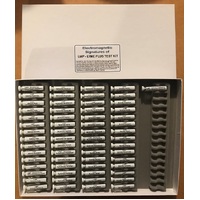LWP Lyme Plus Test Kit
61 vials, Includes flat tray storage box
Vial size: 10 x 50mm
Box: White Cardboard Flat Tray Storage Box with Inlay Structure of Cells for the Vials
14 different babesia species, 24 different bartonella species, 21 different borrelia species, 2 ehrlichia. Commonly causing Lymes disease, Cat Scratch disease and Relapsing Fever. For use by AK practitioners, NAET practitioners. MORO and BICOM practitioners etc.
LY 01 Anaplasma Phagocytophilum / Ehrlichia Phagocytophilum
Causes human granulocytic anaplasmosis. Symptoms may include fever, severe headache, muscle aches (myalgia), chills and shaking, similar to the symptoms of influenza. GI symptoms occur in less than half of patients and a skin rash is seen in less than 10% of patients. It is also characterized by thrombocytopenia, leukopenia, and elevated serum transaminase levels in the majority of infected patients.
LY 02 Babesia Bigemina
North and South America, Southern Europe, Africa, Asia and Australia.
LY 03 Babesia Bovis
Infects cattle and occasionally humans. Eradicated from the United States by 1943, but is still present in Mexico and much of the world's tropics.
LY 04 Babesia Canis
LY 05 Babesia Cati
LY 06 Babesia Divergens
Has been found in Turkey, Spain, Canary Islands, Tunisia, Austria, France and Norway. Infections have a much higher fatality rate (42%) than with other strains and present with the most severe symptoms: haemoglobinuria followed by jaundice, a persistently high fever, chills and sweats. If left untreated, can develop into shock-like symptoms with pulmonary oedema and renal failure.
LY 07 Babesia Duncani
Can infect humans.
LY 08 Babesia Felis
LY 09 Babesia Gibsoni
LY 10 Babesia Herpailuri
LY 11 Babesia Jakimoni
LY 12 Babesia Major
LY 13 Babesia Microti / Theileria Microti / Babesia Vulpes
Common in US. For 25% of cases in adults and half of cases in children, the disease is asymptomatic or mild with flu-like symptoms. Symptoms are characterized by irregular fevers, chills, headaches, general lethargy, pain and malaise.
LY 14 Babesia Ovate
LY 15 Babesia Pantherae
LY 16 Bartonella Alsaticca
LY 17 Bartonella Arupensis
LY 18 Bartonella Bacilliformis
Causes Carrion's disease (Oroya fever, Verruga peruana).
LY 19 Bartonella Berkhoffii
Becoming more important particularly for immuno-compromised individuals.
LY 20 Bartonella Birtlesii
LY 21 Bartonella Bovis
LY 22 Bartonella Capreoli
LY 23 Bartonella Clarridgeiae
Found in domestic cats and can give humans Cat Scratch Disease.
LY 24 Bartonella Doshiae
May cause Cat Scratch Disease.
LY 25 Bartonella Elizabethae / Rochalimaea Elizabethae
Endocarditis. Particularly among homeless IV drug users.
LY 26 Bartonella Grahamii
Endocarditis and Neuroretinitis.
LY 27 Bartonella Henselae / Rochalimaea Henselae
Can cause bacteremia, endocarditis, bacillary angiomatosis, and peliosis hepatis. Causes cat-scratch disease.
LY 28 Bartonella Koehlerae
Human infection may be from infected cats.
LY 29 Bartonella Melophagi
Discovered in 2007 and known to infect humans.
LY 30 Bartonella Muris
LY 31 Bartonella Peromyscus
LY 32 Bartonella Quintana / Rochalimaea Quintana / Rickettsia Quintana
Causes trench fever. Can start out as an acute onset of a febrile episode, relapsing febrile episodes, or as a persistent typhoid-like illness. Commonly seen are maculopapular rashes, conjunctivitis, headache and myalgias, with splenomegaly being less common. Most patients present with pain in the lower legs (shins), sore muscles of the legs and back, and hyperaesthesia of the shins.
LY 33 Bartonella Rochalimae
Carrion's disease-like symptoms.
LY 34 Bartonella Schoenbuchii
LY 35 Bartonella Talpae
LY 36 Bartonella Taylorii
LY 37 Bartonella Tribocorum
LY 38 Bartonella Vinsonii / Rochalimaea Vinsonii
On increase. Causes endocarditis, arthralgia, myalgia, headaches and fatigue.
LY 39 Bartonella Washoensis
May cause fever and myocarditis.
LY 40 Borrelia Afzelii
One of the main causes of Lyme’s disease. Has been found in Europe, USA, Singapore, Australia and New Zealand.
LY 41 Borrelia Berbera
Found in Algeria, Tunisia and Libya.
LY 42 Borrelia Burgdorferi
One of the main causes of Lyme’s disease. Found in USA, Europe, Australia, New Zealand.
LY 43 Borrelia Carteri
Uncommon but has been found in humans in India.
LY 44 Borrelia Caucasica
Found in Europe and Asia.
LY 45 Borrelia Duttonii
Found in Europe and Africa. Causes Central African relapsing fever.
LY 46 Borrelia Garinii
One of the main causes of Lyme’s disease. Has been found in Europe.
LY 47 Borrelia Hermsii
Associated with relapsing fever. The primary cause of tick-borne relapsing fever in North America. Also found in Europe.
LY 48 Borrelia Hispanica
Found in Spain, Portugal, Morocco and central Africa.
LY 49 Borrelia Kochis
LY 50 Borrelia Miyamotoi
Symptoms of relapsing fever. Found in Russia, Japan, Europe and North America.
LY 51 Borrelia Morganii
LY 52 Borrelia Novyi
Found in the Americas.
LY 53 Borrelia Parkeri
Human infection.
LY 54 Borrelia Persica
Found in Europe and Asia.
LY 55 Borrelia Recurrentis
Found in England, Ireland, USA, Canada, Mexico, Central and South America, central Asia, Africa, and around the Mediterranean.
LY 56 Borrelia Tillae
Found in Europe.
LY 57 Borrelia Turicatae
Found in Europe.
LY 58 Borrelia Valaisiana
Causes Lyme's disease.
LY 59 Borrelia Venezuelensis
Causes relapsing fever in Central and South America.
LY 60 Borrelia Vincentii
Exists normally in the human mouth in low concentrations and safe proportions. Causes severe ulcerating gingivitis (trench mouth); typically found in those with poor oral hygiene but can also occur as a result of stress, cigarette smoking and poor nutrition; also can be found in those with serious illnesses.
LY 61 Ehrlichia Chaffeensis / Human Monocytic Ehrlichiosis
Causative agent of human monocytic ehrlichiosis.
(TKlyme)
| SKU | TKlyme |
Be The First To Review This Product!
Help other Equilibrium Kinesiology Supplies users shop smarter by writing reviews for products you have purchased.











